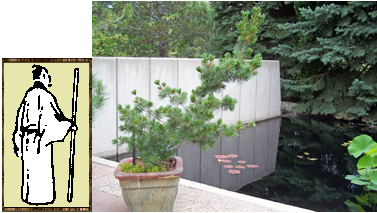
Hexagram Twenty-four—Returning
Hexagram Twenty-four deals with the idea of returning, coming back, or doing things over again. At first there will be no error, despite many troubles. But there must be a change of attitude, a humbling experience, in the end, which will mark defeat and much grief. The only way to avoid this is to strive for complete honesty and integrity.
The first line, yang, shows some errors, even repeated errors, but no obvious consequences.
The second line, yin, shows a happy return, with no errors.
The third line, yin, shows one who has made repeated returns, each time having to do the work over again. But the person is steadfast in their work, so there is no fault.
The fourth line, yin, shows a person who is able to adopt the right attitude and return to the proper path.
The fifth line, yin, shows one who is able to take an honest look at themself, and admit their mistakes. This is a noble position and this person is well situated on their path.
The sixth line, yin, shows one who has gone astray. The base elements of the person, and of society, challenge the finer elements. This brings bad fortune, and if let go to the extreme will eventually bring legal, or other serious problems.
Hexagram Twenty-four Commentary
This hexagram explains second chances. The introduction says it's "the idea of returning, coming back, or doing things over again." If the subject gets a second chance at a situation botched up in the past, the best way to change the outcome is "to strive for complete honesty and integrity."
The first line, the only yang line, shows the subject repeating errors, but nothing bad happens. Things will seem okay at first, but if the errors fouled things up the first time, it could turn bad again if the subject repeat the same mistakes.
The second line, yin, shows a happy return to a situation where the subject did everything correctly the first time. Everything is fine in this return.
The third line, yin, shows one who returns to a situation where the same amount of hard work is waiting, and they have to work hard again to get everything done. Even if the work is difficult, the correct attitude is to keep at it. This also goes for routine chores people do over and over as time goes by.
The fourth line, yin, shows someone who returns to a situation with a better attitude than before. Simply due to this change, the person gets back on the proper path.
The fifth line, yin, shows someone who can look at their own mistakes objectively. This is a good quality and noble position for moving forward in life.
The sixty line, yin, shows the opposite—a person who cannot come to terms with their own bad attitudes and bad habits. This is unfortunate because repeated failures can lead to legal issues or other serious problems.
To the reader: Most of the hexagrams have at least one line that predicts bad results, but that does NOT mean you are fated to that result. The hexagrams illustrate different attitudes, so study the actions and reactions to learn the attitudes that will lead to better outcomes.
The I Ching teaches you to flow with changes and create positive change from the inside through conscious living. Your future is in your hands. Consult the I Ching for ideas that lead to clear thinking and positive mental attitude. Reading the I Ching helps you take the time to reflect on your attitudes and ideas. Continue asking until you feel positive about your course.

Click here for another hexagram.
A note about this interpretation of the I Ching: Nori Muster wrote this version of the I Ching in 1994 and put it online at Surrealist.org in 2000. It is also available at Amazon:
e-book
paperback
